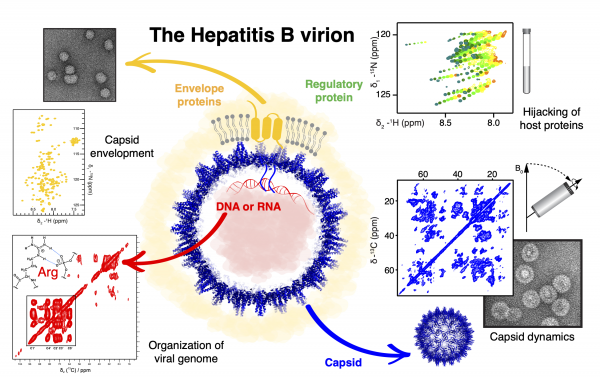Elucidating the Assembly and Life Cycles of Viruses at the Molecular Level
Virions are a fascinating class of pathogenic agents behind major infections afflicting humans. Some viruses encode for only a handful of proteins, which combine in multifunctional ways to sustain the life cycle of the virus. To this purpose, they assume multiple conformations and form transient interactions, making viral proteins challenging targets for structural investigations.
We employ nuclear magnetic resonance (NMR) methods, in solution and solid phase, electron microscopy, and biophysical methods to investigate these intriguing biological assemblies. Our goal is to understand the supramolecular organization of virions: the self-assembly of capsid proteins, their attachment to the lipid envelope, the packaging of nucleic acids inside the capsid and, ultimately, the hierachy and timing of the events that underlie virion maturation.
Read about our research here: J. Am. Chem Soc. 2022, Annu. Rev. Virology 2020.

Schematic overview of the enveloped Hepatitis B virion. Not all building blocks are structurally well defined yet. Our mission is to fill in the gaps here.
Our research is not limited to static componentens of the virions. Very little is known about those elements of the virion that lack a defined three-dimensional structure altogether. This includes the motions of flexible protein segments and irregular capsid-envelope interactions, conformational transitions in the small regulatory protein of the virus and the chemical composition and physical properties of the lipid membrane in the virus envelope.
The connection of molecular features to the viral life cycle, guided by phylogenetic analysis, can identify starting points for strategies to interfere with life cycle of the virus and inhibit its replication. To this end, we maintain close collaborations with medical scientists and virologists in Munich and Heidelberg in a researcher network focusing on hepatotropic viruses (Hepatitis A-E).